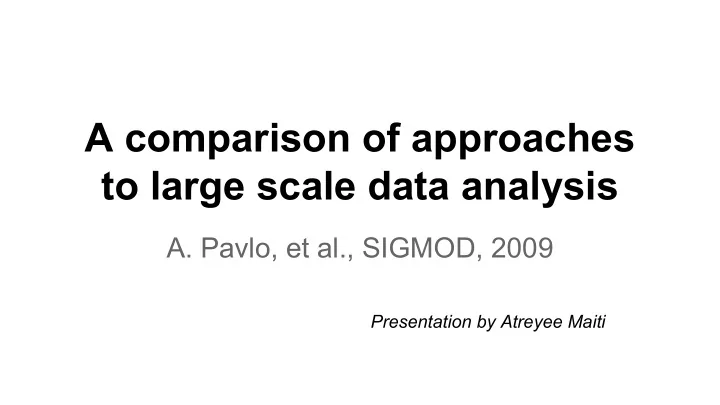

A comparison of approaches to large scale data analysis A. Pavlo, et al., SIGMOD, 2009 Presentation by Atreyee Maiti
Motivation ● MapReduce: A major step backwards? ○ basic control flow of this framework has existed in parallel DBMS for over 20 years ○ parallel DBMS provide a high-level programming environment and parallelize readily ○ possible to write almost any parallel processing task as either a set of database queries or a set of MapReduce jobs ● An attempt to evaluate in terms of performance and development complexity ● Provide a systematic analysis of the design choices made in these two paradigms and the repercussions of those
Approach to analysis ● Benchmark consisting of a collection of tasks run ● Measure each system’s performance for various degrees of parallelism on a cluster of 100 nodes VS He who must not be named ;)
Map Reduce
Parallel Databases ● Tables are partitioned over the nodes in a cluster ● System uses an optimizer that translates SQL commands into a query plan whose execution is divided amongst multiple nodes Filtered Filtered Table 1 Filtered Table 1 Filtered Table 1 Filter over some Table 1 predicate in parallel Table 1 Join in Aggregate over join Table 1 parallel Table 1 Table 1 Table 1 Table 2 Table 2 Table 2 Table 2 replicated
Architectural elements Parallel databases Map reduce frameworks Schema Support Data needs to conform to the Schema-free. need for a custom relational paradigm parser in order to derive the appropriate semantics for their input records. requires discipline. when no sharing is anticipated, the MR paradigm is quite flexible. Indexing hash or Btree indexing reduces do not provide built-in indexes. the scope of the search dramatically. Most database systems also support multiple indexes per table.
Parallel databases Map reduce frameworks Programming Model State what you want one is forced to write algorithms in a low-level language in order to perform record-level manipulation. there is widespread sharing of MR code fragments to do common tasks, such as joining data sets. To alleviate the burden of having to re- implement repetitive tasks, the MR community is migrating high- level languages on top of the current interface to move such functionality into the run time. Data distribution send the computation to the data data passed onto the next stages of the computation
Parallel databases Map reduce frameworks Execution Strategy push mechanism to transfer data pull mechanism to draw in input (no materialization of the split files - induces large disk seeks files) Flexibility programming environments like SQL does not facilitate the RoR allow developers to benefit desired generality that MR from the robustness of DBMS provides. technologies without the burden of writing complex SQL
Parallel databases Map reduce frameworks Fault tolerance larger granules of work (i.e., if a unit of work fails, then the transactions) that are restarted MR scheduler can in the event of a failure. automatically restart the task on an alternate node.
Experiments carried out ● Original MR task - grep task - representative of MR use cases ○ Loading ○ Execution ● Analytical tasks - HTML documents processing similar to web crawler ○ Loading ○ Selection ○ Aggregation ○ Join ○ UDF Aggregation ● Both DBMS-X and Vertica execute most of the tasks much faster than Hadoop at all scaling levels.
Findings Loading time
Task execution time
Analytical tasks Documents, UserVisits and Rankings tables
Aggregation task
Join and UDF
Analysis of the results User level aspects System level aspects ● Ease of use ● System Installation, ● Additional tools Configuration, and Tuning ● Task Start-up ● Compression ● Loading and Data Layout ● Execution Strategies ● Failure Model
● DBMS-X was 3.2 times faster than MR and Vertica was 2.3 times faster than DBMS-X. ● Parallel DBMS-X lesser energy needs. ● B-tree indices, novel storage mechanisms, aggressive compression techniques and sophisticated parallel algorithms for querying large amounts of relational data. ● Hadoop has upfront cost advantage - hence attracted such a large user community. ● Extensibility is USP of MR ● Fault tolerance of MR ● It comes with a potentially large performance penalty, due to the cost of materializing the intermediate files between the map and reduce phases. ● SQL is particularly bad ● MR makes a commitment to a “schema later” or even “schema never” paradigm. But this lack of a schema has a number of important consequences. This difference makes compression less valuable in MR and causes a portion of the performance difference between the two classes of systems.
Where are we now? Databases with mapreduce support Embracing both Better interfaces for MR SCOPE from Microsoft
Summary ● Different paradigms with areas where each of these shine ● Need for more maturity and tools for MR. Work in progress
References http://www.cs.cmu.edu/~pavlo/courses/fall2013/static/papers/benchmarks-sigmod09.pdf http://vgc.poly.edu/~juliana/courses/cs9223/Lectures/paralleldb-vs-hadoop.pdf http://cacm.acm.org/magazines/2010/1/55743-mapreduce-and-parallel-dbmss-friends-or-foes/fulltext http://www.datanami.com/datanami/2013-02-05/weighing_mapreduce_against_parallel_dbms.html http://homes.cs.washington.edu/~billhowe/mapreduce_a_major_step_backwards.html http://research.google.com/archive/mapreduce-osdi04-slides/index-auto-0032.html
Recommend
More recommend